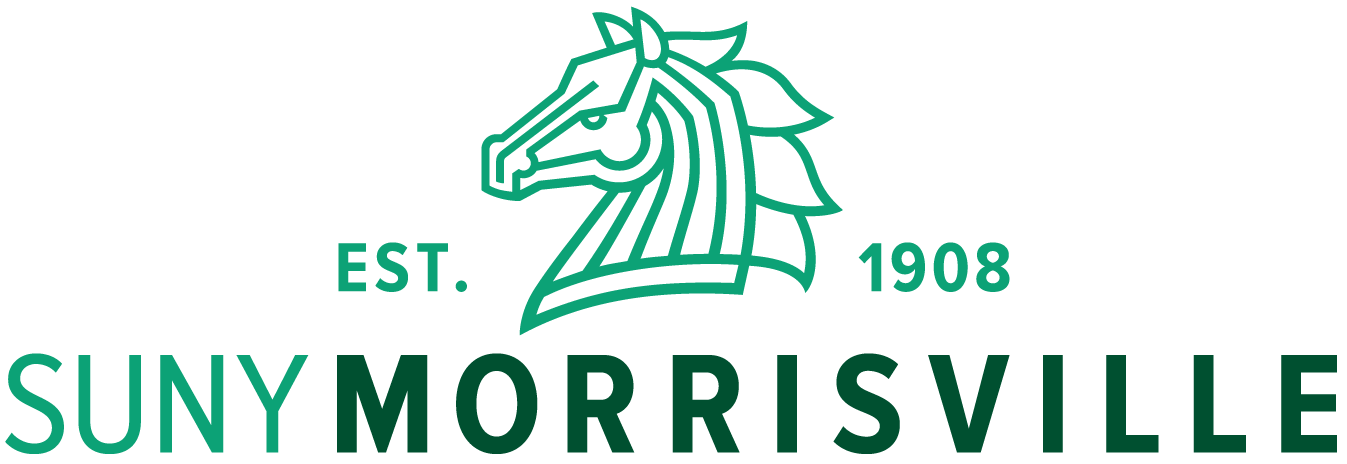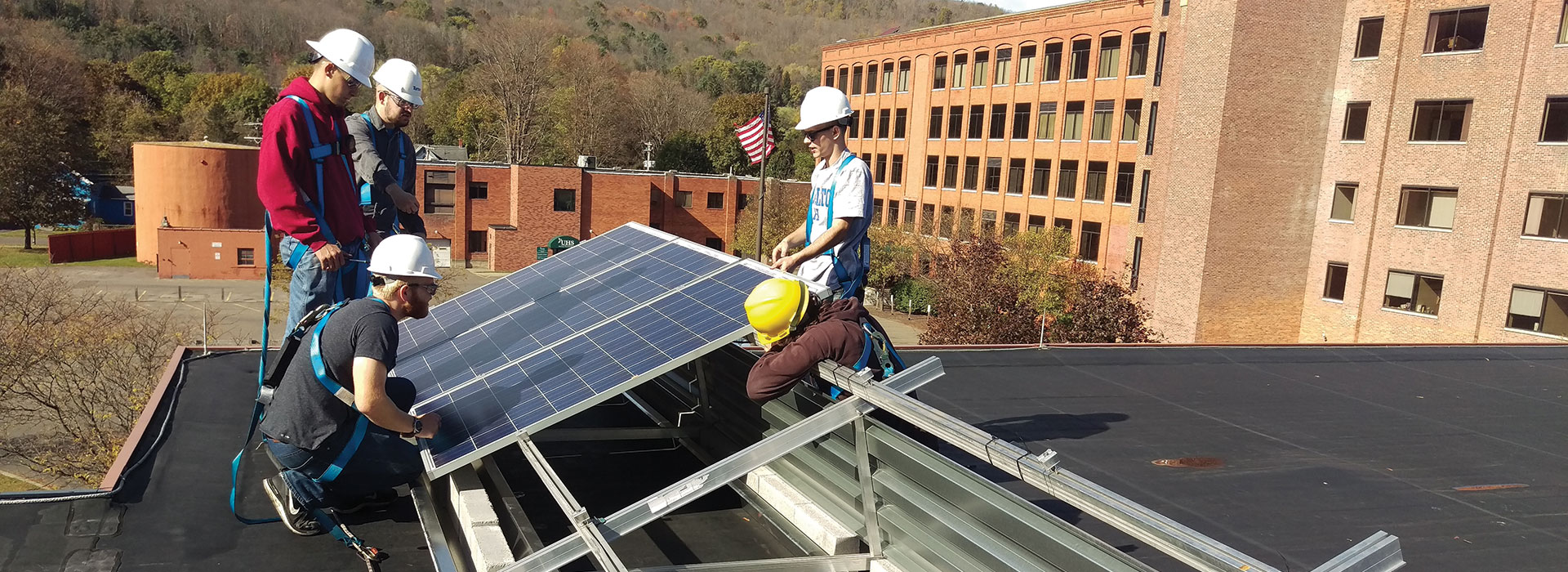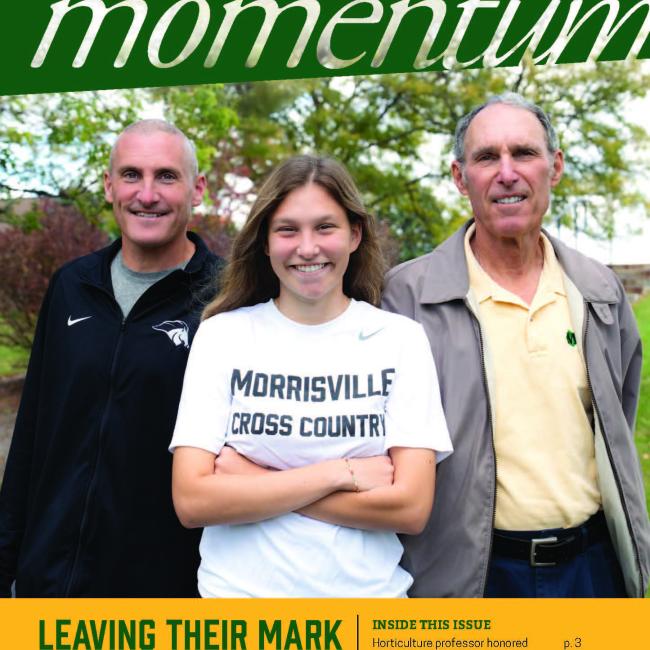Alumni and students play a role in harnessing community solar energy
In Tompkins County, 6,804 solar panels sit on a 13-acre plot of farmland in the town of Endfield. The 2.3-megawatt solar array helps power 373 households, reducing greenhouse gases by 1,430 metric tons annually, the equivalent of removing 306 cars from the road.
The project came to life with the help of a group of graduates from SUNY Morrisville, who are leading the way in creating a community solar empire in Upstate New York.
The growing industry harnesses the financial benefits of solar energy without the monetary investment by individual homeowners. Instead of installing solar panels on their own homes, customers subscribe or buy into larger scale solar installations.
Community solar has been bolstered by New York State Gov. Andrew Cuomo’s mandate that half of all electricity consumed must come from renewable energy sources by 2030. The effort to support and scale sustainable solar is already seeing results, leveraging $2.8 billion in private investments and creating more than 12,000 solar jobs across the state since 2011.
"Clean, renewable energy is critical to combating climate change and protecting our environment for current and future generations of New Yorkers," Cuomo said of the Endfield project developed by BlueRock Solar last year. "With the addition of this community solar project, we are continuing our commitment to a green future and to a more resilient, affordable energy grid."
Preparing students for the growing industry
SUNY Morrisville professor Philip Hofmeyer has been giving his students hands-on experience in solar panel installation for years, exposing them to “real” systems through community and campus projects.
But while residential solar projects are still a big part of his curriculum, Hofmeyer has broadened his focus to include the growing industrial and community solar farms being planted across Upstate New York.
Both the two- and four-year renewable energy degree programs are preparing students for the industry, from installation and maintenance to system design, optimization, permitting and project operations.
Within the industry, the explosion of growth is referred to as the “solar coaster,” with developers trying to find ideal locations for large-scale arrays.
Hofmeyer gets requests daily from employers looking for qualified students, who go on to high-paying jobs across the country in an industry that continues to grow.
“We’ve been trying to be ahead of the curve, because this is the future,” he said. “It will help us balance out the grid.”
Buying into the future
Sam Doubleday came to SUNY Morrisville as an adult student wanting to learn more about the renewable energy industry. With an undergraduate degree in environmental science, Doubleday found his interest piqued with classes in wind turbines, bioenergy and micro-hydro.
His required internship connected him with BlueRock Energy in Syracuse, New York, which turned into a full-time job working for their LED lighting and efficiency division. When the company wanted to expand into solar energy projects, Doubleday jumped at the chance. He brought on fellow SUNY Morrisville alumnus Stephen Sgarlata, who was one of the first students to receive a bachelor’s degree in renewable energy in 2013.
“New York is being very progressive, and we are poised for a lot of growth in the solar industry,” said Sgarlata, who also received an associate degree in automotive technology from Morrisville in 2003 before joining the military for five years of active duty. “It is definitely the future. More and more people are buying into this.”
Sgarlata pointed out that in the past, people who couldn’t install their own solar panels would pay a premium to the utility to tap into renewable options.
Now, by subscribing to a community solar project, customers can get green energy at a savings.
“Everyone can be a part of renewable energy with community solar,” said Doubleday, project coordinator at BlueRock Solar. “By signing up, you are becoming part of the green community and helping propel the state’s strategic energy goals of more green energy generation and less fossil fuel usage.”
Doubleday said the industry has also been a boon for farmers, who can contract with energy companies to put low-impact solar arrays on previously unusable land. Even the maintenance can be accomplished through agriculture; some solar projects partner with area farmers who bring their sheep to graze on the grass around the panels.
“There are no moving parts and the fuel is free,” Doubleday said. “It’s a wonderful avenue to bring more green-generated electricity to the grid.”
Connecting customers
In the 1980s, Michael Roach studied environmental science at SUNY Morrisville; he returned in his 50s to pursue a degree in renewable energy.
“Years ago, renewable energy was a good idea but it was far too expensive to be viable,” he said. “But now, the market changes have brought it to the forefront and New York State has created a pretty supportive ecosystem for this kind of activity.”
Now a solar project developer for RER Energy Group and its sister company, Sunvestment Energy Group, Roach helps connect potential customers — including municipalities and nonprofits — with the financial benefits associated with the community solar farms.
He also educates customers about the benefit of choosing a community solar project that hires local contractors and uses local banks to finance panels.
“We are generating electricity that goes into distribution on the grid right outside our house,” he said. “It is generated locally and it stays local. That is the model that brings the most benefit to the local community.”
A bright future
When Meghan Way began her degree in renewable energy at SUNY Morrisville, she was one of two women in her class.
She quickly found her place in the program, where the concepts covered in class lectures are reinforced by working on live systems on campus. Her diverse curriculum included climbing outdoor power towers and donning some unexpected accessories.
“Never in my life did I think I would ever purchase a welding helmet,” she said with a laugh. “But the whole program was a really good fit. The professors were knowledgeable and always willing to help.”
An internship during her senior year turned into her first full-time job as a permitting and development administrator for a residential wind turbine company in Western New York.
Since then, she has dabbled in a variety of green energy industries, including overseeing state certification and on-site issues for a geothermal installation company.
Currently, she works for SMSA Architectural Services as an alternative energy specialist, helping determine whether solar, geothermal, wind or other resources are a good fit for new residential and commercial builds.
Way said the future is bright in the renewable energy industry.
“There are so many more options than just burning fossil fuels,” she said. “We can do so much to generate our own electricity, to make it as efficient as possible.”
And the reputation of the renewable energy programs at SUNY Morrisville has also been growing.
“The program has really made a name for itself,” she said.
Internship opens doors
The explosion of community solar projects across Upstate New York had a technical assist from another SUNY Morrisville alumnus.
Colton Evans ’16 came to Morrisville to play football as an outside linebacker, where he was named a USA Division III College Football Preseason All-American. Initially pursuing a degree in health performance and sports nutrition, he later changed his focus to web development and management because of the career potential.
During his senior year, Evans secured a 12-week internship at BlueRock Energy with the help of fellow alumnus Sam Doubleday, who needed website assistance for the upcoming solar projects.
The relationship led to a full-time position at BlueRock as a marketing analyst upon graduation, with Evans handing the emails, digital advertisements and targeted marketing on social media for the growing solar enterprise. He worked to create a more secure online contract to help retain customers and encourage them to enroll in the upcoming arrays.
“There’s so much that people don’t think about when they turn on their lights,” Evans said.
Evans now works as a pricing manager for SmartestEnergy, tracking the electricity industry and creating pricing models.
He said his internship at SUNY Morrisville led him into his bright career path.
“It opened the door into this industry that I have never even thought of pursuing,” Evans said.
How community solar works
Instead of installing solar panels on their homes or businesses, customers can subscribe or invest in community solar arrays.
The large-scale installation creates electricity that is fed into the local power grid.
Subscribers will see lower monthly electricity bills, and additional benefits include reduced greenhouse gas emissions and investment in local communities.
Source: NY-Sun, a project of NYSERDA


